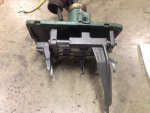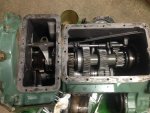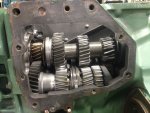- 3,386
- 1,433
- 113
- Location
- The actual midwest, NM.
Last night I thought about doing it "in reverse", as I think you are suggesting; mount the plate to the back of the bucket and let that dictate where the parts end up. It sure would simplify the positioning if using adapter parts that aren't tied together.
Of course, it wouldn't take much to tie the two parts together temporarily, using a known to be good plate.
I could use a setup for front hydraulics like what you describe. It'd let me use the grapple on the rock bucket, and angle the plow blade (normally used on the tractor), among other things. I probably wouldn't use a joy stick, but rather regular valves. It'd be easy enough to mount them to the back of the cab since the lever is usually reversible relative to the valve body.
But then there's reality. In my case that means it won't happen anytime soon. Heck, I still have to make brackets for the QD fittings for the snow blower hoses, and hook up the electrical control for it. Last winter it was alligator clips on one battery, and the cord for the controller coming in through the vent window.
On the other hand, I have to get in hydraulic mode here, soon. For two years now the poorly made remote valves on a Kubota L3800 have been a huge irritant, and time consuming. They leak down at an amazing rate, so some sort of concoction of quality aftermarket valves will take their place. Naturally, I'm bent on cramming them into the stock position, and making an adapter to mount and feed them off the block like the stockers. While I don't mind the exposed valves all over the place on a SEE, on that tractor I want it all to remain invisible.
With all the numbers and thoughts whirring around in my head from that hydraulic adventure, the SEE would be a piece of cake to modify as a follow-up act.
Of course, it wouldn't take much to tie the two parts together temporarily, using a known to be good plate.
I could use a setup for front hydraulics like what you describe. It'd let me use the grapple on the rock bucket, and angle the plow blade (normally used on the tractor), among other things. I probably wouldn't use a joy stick, but rather regular valves. It'd be easy enough to mount them to the back of the cab since the lever is usually reversible relative to the valve body.
But then there's reality. In my case that means it won't happen anytime soon. Heck, I still have to make brackets for the QD fittings for the snow blower hoses, and hook up the electrical control for it. Last winter it was alligator clips on one battery, and the cord for the controller coming in through the vent window.
On the other hand, I have to get in hydraulic mode here, soon. For two years now the poorly made remote valves on a Kubota L3800 have been a huge irritant, and time consuming. They leak down at an amazing rate, so some sort of concoction of quality aftermarket valves will take their place. Naturally, I'm bent on cramming them into the stock position, and making an adapter to mount and feed them off the block like the stockers. While I don't mind the exposed valves all over the place on a SEE, on that tractor I want it all to remain invisible.
With all the numbers and thoughts whirring around in my head from that hydraulic adventure, the SEE would be a piece of cake to modify as a follow-up act.





![DSCN0732[1].jpg DSCN0732[1].jpg](https://www.steelsoldiers.com/data/attachments/478/478968-afc551ab0d8551eb4fedca3c8f3f8f34.jpg)
![DSCN0733[1].jpg DSCN0733[1].jpg](https://www.steelsoldiers.com/data/attachments/478/478969-b8f1173fd1ca7bd0c1bc9ca13bea3ac2.jpg)